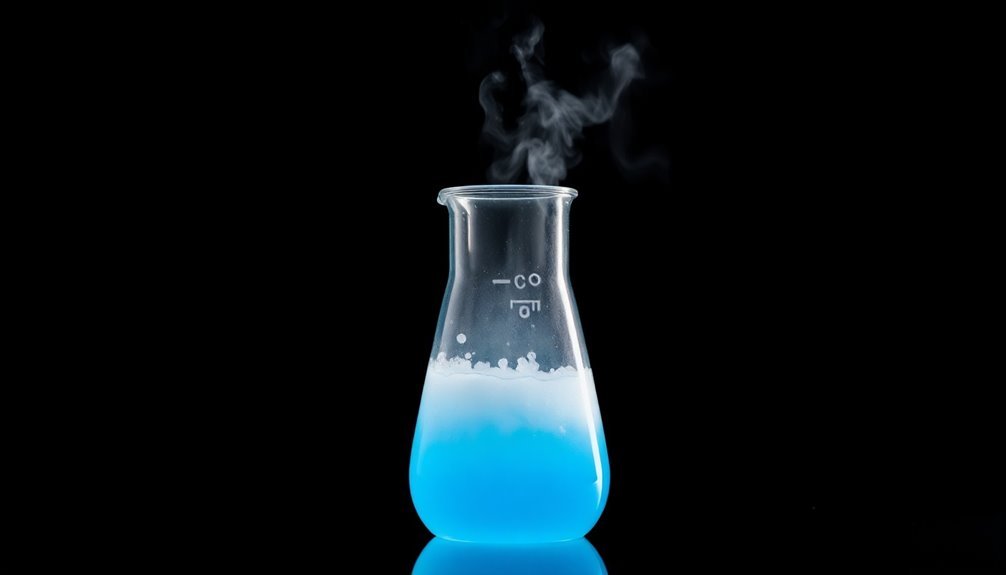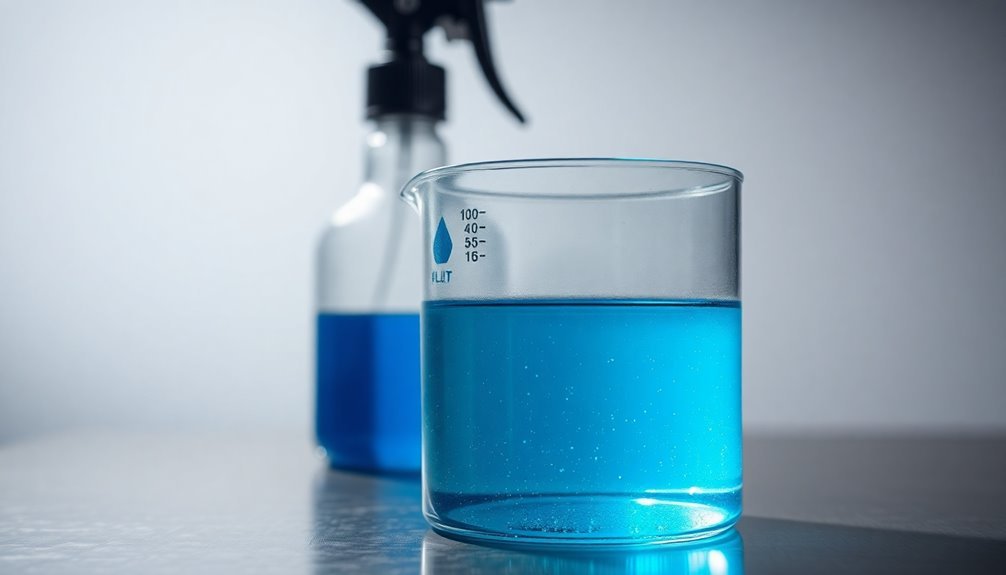Your anti-static spray contains more than just a simple solution – it's a carefully engineered mixture of key compounds. The main ingredients include quaternary ammonium compounds (5-10%) that neutralize static charge, solvents like water or alcohol that carry these active ingredients, and surfactants that help the solution spread evenly across surfaces. You'll also find propellant gases in aerosol versions and protective silicone additives that guard against moisture and dust. While these chemicals effectively prevent static buildup, they require proper handling and disposal due to their environmental impact. Understanding what's inside can help you use these products more safely and effectively.
Key Ingredients at a Glance

Anti-static sprays contain a carefully balanced mix of ingredients that work together to combat static electricity.
You'll find four essential components in most formulations: a solvent, surfactant, active ingredients, and propellants. The solvent, typically water, alcohol, or hydrocarbons, acts as the carrier fluid that disperses other compounds effectively across surfaces.
The surfactant's role is vital – it reduces surface tension, ensuring the solution spreads evenly and adheres well to your materials. The spray is dispensed through an ergonomic actuator design that enables precise control during application.
You'll notice quaternary ammonium compounds as the primary active ingredients, making up 5-10% of the mixture. These chemicals are responsible for neutralizing the static charge on surfaces.
If you're using a spray can, there's also a propellant gas that helps dispense the product as a fine mist.
Many formulations include additives like silicone for extra protection against moisture and dust.
You might encounter specific chemicals like propan-2-ol (with exposure limits of TWA: 200 ppm, STEL: 400 ppm) and 2-butoxyethanol (TWA: 20 ppm, STEL: 50 ppm) in commercial products.
These ingredients create a powerful solution that effectively manages static electricity in various applications.
Safety Concerns You Should Know
While understanding the ingredients helps you make informed choices, knowing proper safety protocols can protect you from potential hazards when using these sprays. A basic mixture of water and softener creates the core solution for effectiveness. You'll need to be particularly mindful of proper ventilation, as inhaling solvent vapors can cause dizziness, headaches, and nausea.
If you're using these products regularly, you should know that prolonged exposure might lead to chronic central nervous system issues and delayed lung damage.
For your safety, always follow these essential precautions:
- Open windows and doors before spraying, creating cross-ventilation that whisks away harmful vapors
- Wear protective goggles to shield your eyes from accidental spray mist that could cause redness and pain
- Keep a safe distance from any heat sources or open flames, as these sprays are classified as flammable liquids
- Remove contaminated clothing immediately if the spray contacts your skin, followed by thorough washing
If you experience any adverse reactions, don't hesitate to seek medical attention. Remember to store your anti-static spray in a cool, dry place away from heat sources, and never induce vomiting if accidentally swallowed. Instead, contact medical professionals right away.
Environmental Impact and Disposal

Understanding the environmental footprint of anti-static sprays reveals significant concerns for our ecosystems. These products contain hazardous substances like nitrate amine salts and 2-Butoxyethanol that are particularly toxic to aquatic life. Tests show alarming toxicity levels, with specific chemicals having high LC50 and EC50 values that can harm marine and freshwater organisms.
You'll need to be especially careful when disposing of anti-static spray cans. These products are classified as environmentally hazardous substances and require specific handling procedures. Even emptied cans can be dangerous since they contain remaining propellants. If you're disposing of aerosol cans, you'll need to follow EPA regulations by using proper puncturing and draining systems like Aerosolv.
Don't forget to wear protective equipment during disposal.
The chemicals in these sprays don't easily degrade and can persist in the environment for extended periods. While you can recycle empty cans as scrap metal, you must properly dispose of their contents according to local regulations.
Companies are now shifting toward more sustainable alternatives, including biodegradable materials, but most current anti-static sprays still contain non-biodegradable components that pose long-term environmental risks.
When using these products, consider their environmental impact and explore eco-friendly alternatives whenever possible.
How These Chemicals Work Together
Blending multiple chemical compounds creates the unique static-reducing properties of these sprays. When you apply an anti-static spray, quaternary ammonium compounds and ethyldimethyl alkyl sulfates work together to form a microscopically thin conductive layer on surfaces.
The solvent, typically propan-2-ol or water, acts as the carrier, guaranteeing even distribution of these active ingredients. Parallel phrasing maintains consistency in describing each chemical's role in the formula.
Surfactants play a vital role by lowering surface tension, which allows the solution to spread effectively across materials. You'll find that these chemicals create a synchronized effect where each component serves a specific purpose:
- The solvent evaporates quickly, leaving behind the active ingredients
- Quaternary ammonium compounds (5-10%) bond to the surface, creating a protective barrier
- Surfactants guarantee the solution doesn't bead up but spreads evenly
- Optional silicone compounds provide additional moisture resistance and dust protection
When combined, these chemicals create a surface that's just conductive enough to prevent charge buildup without being so conductive that it risks damaging sensitive electronics. It's this careful balance that makes modern anti-static sprays both effective and safe for use around electronic equipment.
Proper Storage and Handling Tips

To guarantee safety and maintain effectiveness, proper storage and handling of anti-static spray requires careful attention to specific conditions.
You'll need to store containers upright in designated areas equipped with sprinklers, keeping them away from direct sunlight and heat sources. The storage temperature shouldn't exceed 50°C/122°F, and you must verify the area remains well-ventilated and dry.
When handling anti-static spray, you'll want to work in well-ventilated spaces and wear appropriate protective equipment, including gloves and safety goggles. Don't smoke during application or while treated surfaces are drying. Keep the product away from incompatible oxidizing materials for additional safety.
You should also implement proper grounding techniques to protect your equipment and store treated boards in a static-controlled environment.
You'll need to check the spray's effectiveness monthly and plan for reapplication every 3-6 months, depending on your environmental conditions.
When it comes to disposal, don't puncture or crush containers, even if they're empty. Instead, dispose of waste in sealed containers at licensed facilities, following local regulations.
Regular inspections for damage or leakage are essential to maintain safety standards and guarantee peak performance of your anti-static spray.
Frequently Asked Questions
How Long Does Anti-Static Protection Typically Last After Spraying?
You'll typically get several hours of protection from anti-static spray, but you'll need to reapply sooner if you're in low humidity or using thicker fabrics. Environmental conditions greatly affect its duration.
Can Anti-Static Spray Damage Electronic Screens or Displays?
Yes, anti-static spray can damage LCD, anti-glare, and mesh screens if sprayed directly. You'll want to apply it to a soft cloth first and gently wipe surfaces to protect your electronic displays.
Does the Effectiveness Change in Different Humidity Levels?
Yes, your anti-static spray's effectiveness will vary with humidity. It's most effective in low humidity (below 40% RH) when static is problematic, but you'll notice reduced benefits in higher humidity environments.
Why Do Some Anti-Static Sprays Leave a Residue While Others Don't?
You'll notice residue differences because some sprays use hygroscopic chemicals that attract moisture and stay behind, while others contain fast-evaporating solvents that leave only an invisible conducting layer on surfaces.
Can Anti-Static Spray Be Used on Car Seats and Upholstery?
You can use anti-static spray on car seats and upholstery, but apply it lightly and test in a hidden spot first. For leather seats, use water-based products and don't spray directly on the surface.
In Summary
You're now equipped with critical knowledge about what's in your anti-static spray and how to use it safely. Understanding these chemicals and their interactions helps you make informed decisions about usage and disposal. Remember to store your spray properly, follow safety guidelines, and consider eco-friendly alternatives when possible. Being aware of both benefits and risks lets you use anti-static products responsibly.





Leave a Reply